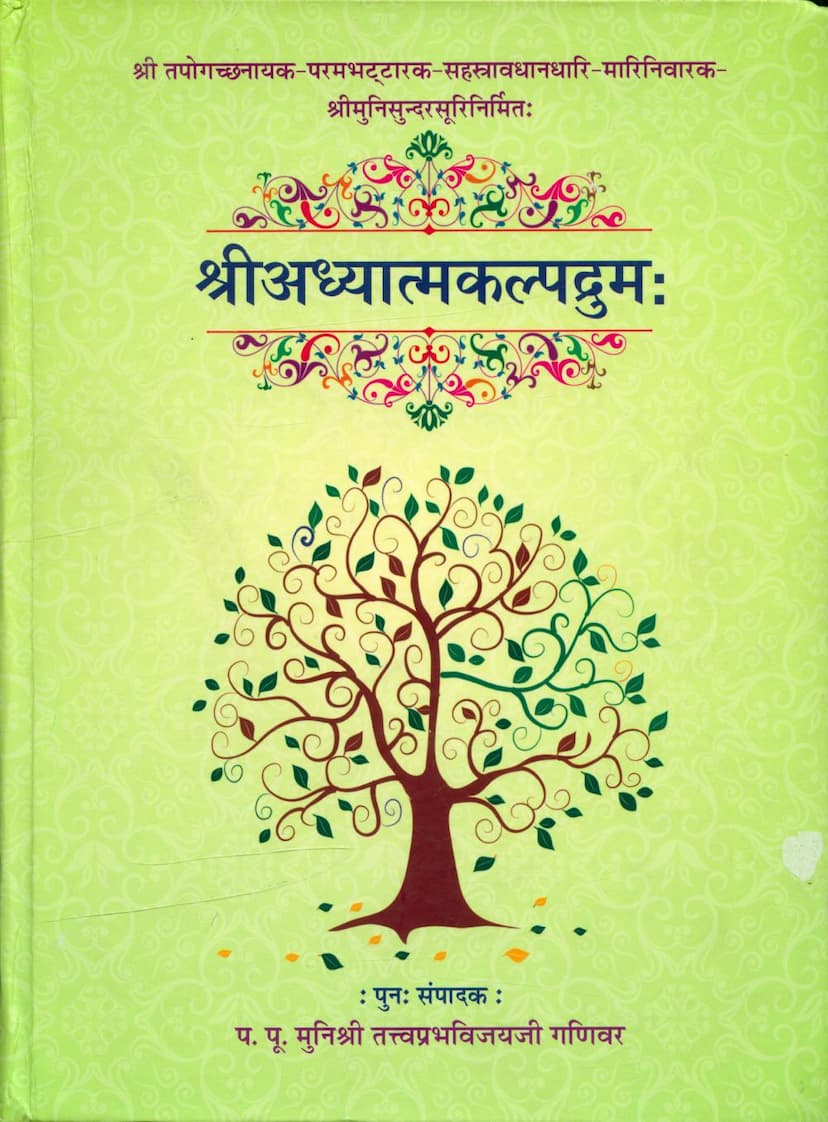Adhyatma Kalpdrum
Added to library: September 1, 2025

Summary
This document is a summary of the Jain text "Adhyatma Kalpdrum" by Tattvaprabhvijay, published by Jinprabhsuri Granthmala. Here's a breakdown of its content:
Core Information:
- Title: Adhyatma Kalpdrum (Spiritual Wish-Fulfilling Tree)
- Author: Shri Munisundarsuri (original author); Edited by Pu. Pu. Muni Shri Tattvaprabhvijay Ganivar.
- Publisher: Jinprabhsuri Granthmala
- Catalog Link: https://jainqq.org/explore/022283/1
- Key Features: The book is presented with two commentaries:
- "Adhirohani" (Ascent) by Upadhyay Shri Dhanvijay Gani, disciple of Mahopadhyay Shri Kalyansurijee.
- "Adhyatma Kalplata" (Spiritual Wish-Fulfilling Creeper) by Upadhyay Shri Ratnachandra Gani, disciple of Shri Shantiquehandra Gani.
- Edition: First Edition
- Publication Year: Vikram Samvat 2072 (2015 CE), Phalgun Vad 30
- Price: ₹450.00
- Contact Information: Details for purchasing the book from Jinprabhsuri Granthmala in Ahmedabad are provided.
Content and Themes (based on the provided pages):
The initial pages of the text focus on:
-
Invocation and Dedication:
- The work is dedicated to Paramabhattarak, Sahasravadhanadharin, Marinnivarak Shri Tapagachhanayak Shri Munisundarsuri, the original author.
- It acknowledges the editors and publishers, highlighting the lineage of Gurus and scholars involved.
- There's a clear intention to revive and republish this important spiritual work, which was previously published by the Devchand Lalbhai Pustakoddhar Fund.
-
The "Adhyatma Kalpdrum" itself:
- It is described as a highly cherished book of Shri Munisundarsuri.
- The book is divided into sixteen chapters (Adhikars), which are listed in the "Granth Peethika" (Book Introduction). These chapters cover various aspects of spiritual development and control:
- Mangalacharan (Invocation)
- Lalana-Mamatva-Mochana Adhikar (Renunciation of Attachment to Women)
- Apatya-Mamata-Mochana Adhikar (Renunciation of Attachment to Children)
- Dhana-Mamata-Mochana Adhikar (Renunciation of Attachment to Wealth)
- Deha-Mamata-Mochana Adhikar (Renunciation of Attachment to the Body)
- Vishaya-Nigraha Adhikar (Control of Senses/Indriyas)
- Kashaya-Nigraha Adhikar (Control of Passions/Kashayas)
- Shastra-Guna Adhikar (Qualities of Scriptures)
- Chitta-Damana Adhikar (Control of the Mind)
- Vairagya-Upadesha Adhikar (Teachings on Detachment)
- Dharma-Shuddhi-Upadesha Adhikar (Teachings on Purity of Dharma)
- Deva-Guru-Dharma-Shuddhi Adhikar (Purity of Deities, Gurus, and Dharma)
- Yati-Shiksha-Upadesha Adhikar (Teachings for Ascetics)
- Mithyatva-adi-Samvara-Upadesha Adhikar (Renunciation of False Beliefs, etc.)
- Shubha-Pravritti-Shiksha-Upadesha Adhikar (Teachings on Auspicious Conduct)
- Samya-Sarvasva Adhikar (The Essence of Equanimity)
- The text highlights the importance of Shanta Rasa (the sentiment of peace and detachment) as central to this work, considering it the best for spiritual knowledge.
-
Commentaries: The presence of detailed commentaries ("Adhirohani" and "Adhyatma Kalplata") indicates a scholarly and analytical approach to the original text, aiming to make its teachings accessible and understandable.
-
Linguistic Discussion: Page 8 onwards features a detailed discussion on "Sandhi: Uchcharan - Parivartan ane Lipi" (Sandhi: Pronunciation - Change and Script). This suggests the edition pays attention to linguistic nuances and the principles of pronunciation and writing in Sanskrit and related languages, which is crucial for accurately understanding and reciting religious texts. It delves into the rules of vowel and consonant combinations and their impact on meaning and script.
Overall Purpose:
The "Adhyatma Kalpdrum," along with its commentaries, aims to guide the reader towards spiritual liberation (Moksha) by systematically addressing the attachments and obstacles that prevent spiritual progress. The chapter titles clearly indicate a progression from renouncing worldly attachments (wealth, family, body) to controlling the mind, senses, and passions, and ultimately understanding the nature of the Divine, the Guru, and true Dharma. The emphasis on "Shanta Rasa" signifies a path of inner peace, equanimity, and detachment from worldly affairs.
This summary is based on the provided page information and title, giving a comprehensive overview of the book's structure, lineage, and the spiritual path it likely expounds upon.